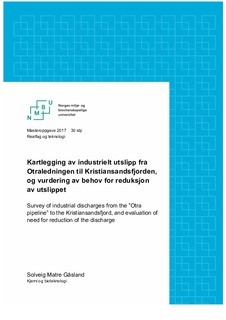| dc.contributor.advisor | Ratnaweera, Harsha | |
| dc.contributor.author | Gåsland, Solveig Matre | |
| dc.coverage.spatial | Kristiansand | nb_NO |
| dc.date.accessioned | 2017-11-08T09:33:13Z | |
| dc.date.available | 2017-11-08T09:33:13Z | |
| dc.date.issued | 2017 | |
| dc.identifier.uri | http://hdl.handle.net/11250/2464843 | |
| dc.description.abstract | Kristiansandsfjorden tilføres mye forurensninger og miljøtilstanden overvåkes. Mange undersøkelser og miljøtiltak har vært gjort for å bedre forholdene. Elva Otra, som renner ut i Kristiansandsfjorden, var tidligere svært forurenset av prosessvann. Otraledningen ble bygget i 1995. Prosessvannet ble ført inn i ledningen, og ut på dypt vann i Østerhavn i Kristiansandsfjorden. Tiltaket forbedret forholdene i Otra betraktelig, og skapte et økt miljøengasjement for situasjonen i Kristiansandsfjorden. I denne oppgaven ble dagens utslipp fra Otraledningen kartlagt. Å kartlegge utslippskilder til Kristiansandsfjorden er en viktig del av prosessen med å nå miljømålene for fjorden.
Prøver ble hentet fra elvevann, Huntonit, Støleheia Avfallsanlegg og Hagen luftekum. Elvevannet fra Otra er det første vannet som føres inn i Otraledningen. Videre slippes prosessvann fra Huntonit og Støleheia Avfallsanlegg på. Ved Hagen luftekum har prosessvannet blitt blandet med elvevannet. Det representerer dermed det samlede utslippet som slippes ut i Kristiansandsfjorden. Vannmengde, Tot-P, konduktivitet, pH, KOF, SS, tungmetaller, tarmbakterier og totalt antall bakterier ble målt.
Analysene viste høye utslipp av KOF, SS og tungmetaller fra Huntonit. Støleheia Avfallsanlegg hadde høye verdier av tungmetaller, tarmbakterier og totalt antall bakterier. Prøvene fra Hagen hadde høye verdier av KOF, sink og kobber.
Vann-nett opplyser at det er en dårlig økologisk tilstand i Kristiansandsfjorden. Sink og kobber er to av flere miljøgifter som har altfor høye nivåer. Tilstanden for KOF er ikke oppgitt, men utslippet fra Otraledningen ligger generelt over kommunale grenseverdier. Av hensyn til miljøsituasjonen i Kristiansandsfjorden, vil det dermed være aktuelt å redusere utslippene av KOF, sink og kobber fra Otraledningen. | nb_NO |
| dc.description.abstract | The Kristiansandsfjord receives much pollution and the environmental state is monitored. Much research and abatement efforts have been done to improve the conditions. The river Otra, which flows into the Kristiansandsfjord, was previously very polluted by industrial waste water. The ”Otra pipeline” was built in 1995. The industrial waste water was lead into the pipeline, and out in deep water in Østerhavn in the Kristiansandsfjord. The efforts improved the conditions in Otra considerably, and created an increased environmental engagement for the situation in the Kristiansandsfjord. In this thesis the present discharges from the ”Otra pipeline” was surveyed. To survey sources of discharges to the Kristiansandsfjord is an important part of the process of reaching the environmental goals for the fjord.
Samples were taken from river water, Huntonit, Støleheia waste facility and Hagen luftekum. The river water is the first water lead into the ”Otra pipeline”. Further the industrial waster water from Huntonit and Støleheia is discharged. At Hagen luftekum the industrial waster water has been mixed with the river water. This represents the total discharges that are released into the Kristiansandsfjord. Water amount, Tot-P, conductivity, pH, COD, SS, heavy metals, gut bacteria and total amount of bacteria were analysed.
The analysis showed high discharges of COD, SS and heavy metals from Huntonit. Støleheia waste facility had high values of heavy metals, gut bacteria and total amount of bacteria. The samples from Hagen had high values of COD, zinc and cobber.
Vann-nett informs that there is a bad ecological state in the Kristiansandsfjord. Zinc and cobber are two of several environmental toxins that have too high levels. The case for COD is not given, but the discharges from the ”Otra pipeline” are generally over the municipal limits. With respect to the environmental conditions in the Kristiansandsfjord, it will be relevant to reduce the discharges of COD, zinc and cobber from the ”Otra pipeline”. | nb_NO |
| dc.description.sponsorship | Kristiansand Ingeniørvesen - Odderøya Renseanlegg | nb_NO |
| dc.language.iso | nob | nb_NO |
| dc.publisher | Norwegian University of Life Sciences, Ås | nb_NO |
| dc.rights | Attribution-NonCommercial-NoDerivatives 4.0 Internasjonal | * |
| dc.rights.uri | http://creativecommons.org/licenses/by-nc-nd/4.0/deed.no | * |
| dc.subject | Otraledningen | nb_NO |
| dc.subject | Industrielt utslipp | nb_NO |
| dc.title | Kartlegging av industrielt utslipp fra Otraledningen til Kristiansandsfjorden, og vurdering av behov for reduksjon av utslippet | nb_NO |
| dc.title.alternative | Survey of industrial discharges from the "Otra pipeline" to the Kristiansandsfjord, and evaluation of need for reduction of the discharge | nb_NO |
| dc.type | Master thesis | nb_NO |
| dc.description.version | submittedVersion | nb_NO |
| dc.subject.nsi | VDP::Teknologi: 500 | nb_NO |
| dc.source.pagenumber | 67 | nb_NO |
| dc.relation.project | Kristiansand Ingeniørvesen - Odderøya Renseanlegg | nb_NO |
| dc.description.localcode | M-KB | nb_NO |

